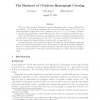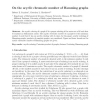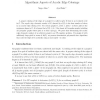46 search results - page 3 / 10 » Coloring with no 2-Colored P4's |
COMBINATORICS
2002
13 years 8 months ago
2002
Erdos, Rubin, and Taylor found a nice correspondence between the minimum order of a complete bipartite graph that is not r-choosable and the minimum number of edges in an r-unifor...
FOCS
2002
IEEE
14 years 1 months ago
2002
IEEE
We prove that coloring a 3-uniform 2-colorable hypergraph with c colors is NP-hard for any constant c. The best known algorithm [20] colors such a graph using O(n1/5 ) colors. Our...
DM
2002
13 years 8 months ago
2002
In 1993, Brualdi and Massey conjectured that every graph can be incidence colored with + 2 colors, where is the maximum degree of a graph. Although this conjecture was solved in ...
GC
2008
Springer
13 years 8 months ago
2008
Springer
An acyclic coloring of a graph G is a proper coloring of the vertex set of G such that G contains no bichromatic cycles. The acyclic chromatic number of a graph G is the minimum nu...
ALGORITHMICA
2002
13 years 8 months ago
2002
A proper coloring of the edges of a graph G is called acyclic if there is no 2-colored cycle in G. The acyclic edge chromatic number of G, denoted by a (G), is the least number of...



